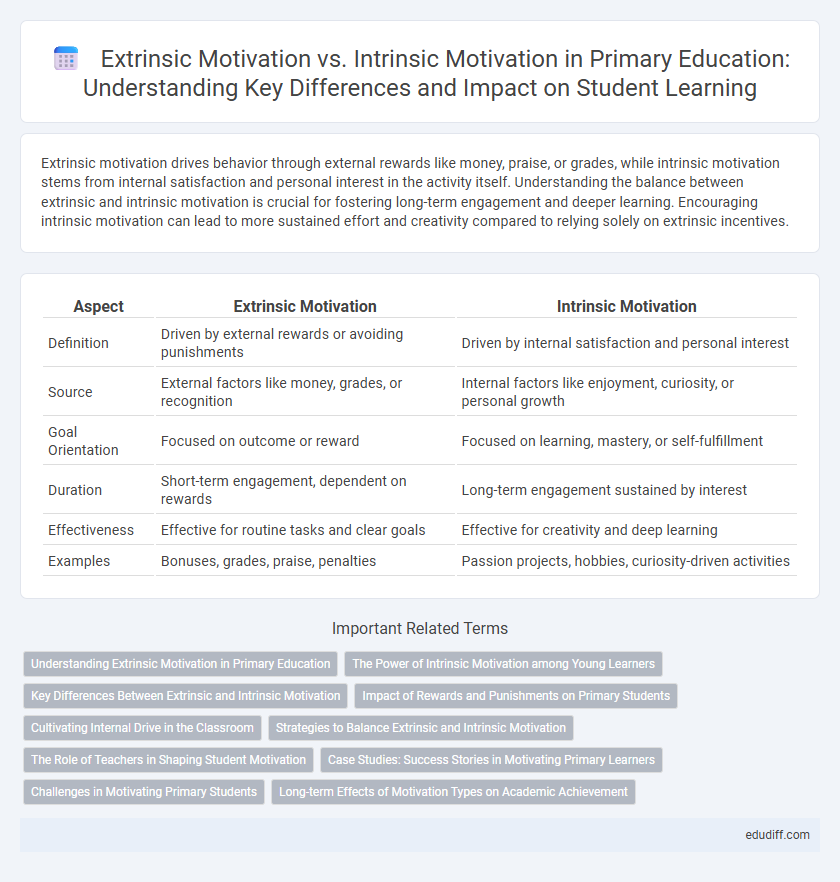Extrinsic motivation drives behavior through external rewards like money, praise, or grades, while intrinsic motivation stems from internal satisfaction and personal interest in the activity itself. Understanding the balance between extrinsic and intrinsic motivation is crucial for fostering long-term engagement and deeper learning. Encouraging intrinsic motivation can lead to more sustained effort and creativity compared to relying solely on extrinsic incentives.
Table of Comparison
| Aspect | Extrinsic Motivation | Intrinsic Motivation |
|---|---|---|
| Definition | Driven by external rewards or avoiding punishments | Driven by internal satisfaction and personal interest |
| Source | External factors like money, grades, or recognition | Internal factors like enjoyment, curiosity, or personal growth |
| Goal Orientation | Focused on outcome or reward | Focused on learning, mastery, or self-fulfillment |
| Duration | Short-term engagement, dependent on rewards | Long-term engagement sustained by interest |
| Effectiveness | Effective for routine tasks and clear goals | Effective for creativity and deep learning |
| Examples | Bonuses, grades, praise, penalties | Passion projects, hobbies, curiosity-driven activities |
Understanding Extrinsic Motivation in Primary Education
Extrinsic motivation in primary education involves using external rewards such as praise, stickers, or grades to encourage students' learning behaviors and academic performance. This approach helps establish initial engagement and compliance, especially when students are developing self-regulation and goal-setting skills. Effective use of extrinsic motivators can complement intrinsic motivation by gradually fostering a love for learning and personal achievement.
The Power of Intrinsic Motivation among Young Learners
Intrinsic motivation drives young learners by fostering curiosity and personal satisfaction, resulting in deeper engagement and better retention of knowledge. Unlike extrinsic motivation, which relies on external rewards, intrinsic motivation nurtures creativity, self-discipline, and a lifelong love of learning. Educators can enhance intrinsic motivation by creating meaningful, relevant experiences that connect with learners' interests and values.
Key Differences Between Extrinsic and Intrinsic Motivation
Extrinsic motivation drives behavior through external rewards such as money, grades, or praise, while intrinsic motivation stems from internal satisfaction and personal interest in the task itself. Key differences include the source of motivation--external versus internal--and the impact on long-term engagement, with intrinsic motivation often leading to sustained persistence and creativity. Research shows intrinsic motivation enhances learning outcomes and overall well-being more effectively than extrinsic motivation, which may only encourage short-term compliance.
Impact of Rewards and Punishments on Primary Students
Extrinsic motivation in primary students often relies on tangible rewards and punishments, which can boost short-term engagement but may undermine long-term interest in learning. Intrinsic motivation, driven by curiosity and personal satisfaction, fosters deeper cognitive development and sustained academic performance. Balancing extrinsic incentives with strategies that nurture internal motivation enhances overall educational outcomes for young learners.
Cultivating Internal Drive in the Classroom
Cultivating internal drive in the classroom involves emphasizing intrinsic motivation by creating learning environments that foster curiosity, autonomy, and mastery. Strategies such as offering meaningful feedback, promoting self-directed projects, and connecting content to students' interests enhance engagement without relying heavily on extrinsic rewards like grades or prizes. This approach supports long-term academic growth by nurturing students' natural desire to learn and achieve.
Strategies to Balance Extrinsic and Intrinsic Motivation
Balancing extrinsic and intrinsic motivation requires integrating goal-setting strategies that align external rewards with personal values to enhance engagement. Incorporating autonomy-supportive techniques, such as offering choices and fostering a sense of competence, promotes intrinsic motivation while maintaining the influence of extrinsic incentives. Regular feedback that emphasizes progress and mastery supports sustained motivation by linking external recognition with internal satisfaction.
The Role of Teachers in Shaping Student Motivation
Teachers play a crucial role in shaping student motivation by creating learning environments that support both extrinsic and intrinsic motivation. They can enhance extrinsic motivation through rewards and recognition while fostering intrinsic motivation by promoting autonomy, competence, and relatedness. Effective teacher strategies include providing meaningful feedback, encouraging self-directed learning, and nurturing students' interests to sustain long-term engagement.
Case Studies: Success Stories in Motivating Primary Learners
Case studies reveal that primary learners show higher engagement and improved academic performance when intrinsic motivation techniques such as autonomy and mastery are prioritized. Programs incorporating extrinsic rewards like stickers and praise boost short-term participation but often fail to sustain long-term enthusiasm. The most successful success stories combine personalized intrinsic motivators with strategic extrinsic incentives to create a balanced, motivating learning environment.
Challenges in Motivating Primary Students
Extrinsic motivation often relies on tangible rewards like stickers or praise, which can temporarily boost primary students' engagement but may undermine long-term interest in learning. Intrinsic motivation, driven by curiosity and personal satisfaction, poses challenges as young students may struggle to connect with abstract concepts without immediate reinforcement. Balancing these motivators requires carefully designed activities that foster autonomy and competence while providing sufficient external support to sustain attention and effort.
Long-term Effects of Motivation Types on Academic Achievement
Extrinsic motivation, driven by external rewards such as grades and praise, can boost short-term academic performance but often leads to decreased engagement and lower persistence over time. Intrinsic motivation, fueled by personal interest and internal satisfaction, is strongly linked to sustained academic achievement and deeper learning. Studies reveal that students with intrinsic motivation demonstrate greater resilience, higher self-regulation, and improved long-term educational outcomes compared to those relying primarily on extrinsic motivators.
Extrinsic Motivation vs Intrinsic Motivation Infographic

 edudiff.com
edudiff.com